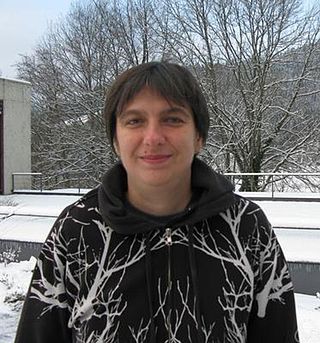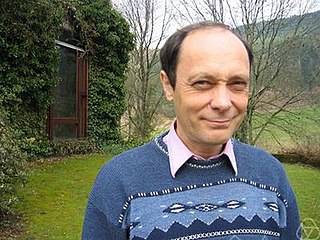Related Research Articles
Algebraic quantum field theory (AQFT) is an application to local quantum physics of C*-algebra theory. Also referred to as the Haag–Kastler axiomatic framework for quantum field theory, because it was introduced by Rudolf Haag and Daniel Kastler. The axioms are stated in terms of an algebra given for every open set in Minkowski space, and mappings between those.
In physics, the Landau pole is the momentum scale at which the coupling constant of a quantum field theory becomes infinite. Such a possibility was pointed out by the physicist Lev Landau and his colleagues. The fact that couplings depend on the momentum scale is the central idea behind the renormalization group.

Rudolf Haag was a German theoretical physicist, who mainly dealt with fundamental questions of quantum field theory. He was one of the founders of the modern formulation of quantum field theory and he identified the formal structure in terms of the principle of locality and local observables. He also made important advances in the foundations of quantum statistical mechanics.

Édouard Brézin is a French theoretical physicist. He is professor at Université Paris 6, working at the laboratory for theoretical physics (LPT) of the École Normale Supérieure since 1986.

Arthur Michael Jaffe is an American mathematical physicist at Harvard University, where in 1985 he succeeded George Mackey as the Landon T. Clay Professor of Mathematics and Theoretical Science.
In theoretical particle physics, the non-commutative Standard Model, is a model based on noncommutative geometry that unifies a modified form of general relativity with the Standard Model.

Vladimir E. Korepin is a professor at the C. N. Yang Institute of Theoretical Physics of the Stony Brook University. Korepin made research contributions in several areas of mathematics and physics.
In theoretical physics, functional renormalization group (FRG) is an implementation of the renormalization group (RG) concept which is used in quantum and statistical field theory, especially when dealing with strongly interacting systems. The method combines functional methods of quantum field theory with the intuitive renormalization group idea of Kenneth G. Wilson. This technique allows to interpolate smoothly between the known microscopic laws and the complicated macroscopic phenomena in physical systems. In this sense, it bridges the transition from simplicity of microphysics to complexity of macrophysics. Figuratively speaking, FRG acts as a microscope with a variable resolution. One starts with a high-resolution picture of the known microphysical laws and subsequently decreases the resolution to obtain a coarse-grained picture of macroscopic collective phenomena. The method is nonperturbative, meaning that it does not rely on an expansion in a small coupling constant. Mathematically, FRG is based on an exact functional differential equation for a scale-dependent effective action.

Jürg Martin Fröhlich is a Swiss mathematician and theoretical physicist. He is best known for introducing rigorous techniques for the analysis of statistical mechanics models, in particular continuous symmetry breaking, and for pioneering the study of topological phases of matter using low-energy effective field theories.

Matilde Marcolli is an Italian and American mathematical physicist. She has conducted research work in areas of mathematics and theoretical physics; obtained the Heinz Maier-Leibnitz-Preis of the Deutsche Forschungsgemeinschaft, and the Sofia Kovalevskaya Award of the Alexander von Humboldt Foundation. Marcolli has authored and edited numerous books in the field. She is currently the Robert F. Christy Professor of Mathematics and Computing and Mathematical Sciences at the California Institute of Technology.

Vincent Rivasseau is a French mathematical physicist.

David Chandos Brydges is a mathematical physicist.

Sergio Doplicher is an Italian mathematical physicist, who mainly dealt with the mathematical foundations of quantum field theory and quantum gravity.

Roberto Longo is an Italian mathematician, specializing in operator algebras and quantum field theory.

Klaus Fredenhagen is a German theoretical physicist who works on the mathematical foundations of quantum field theory.

Giovanni Felder is a Swiss mathematical physicist and mathematician, working at ETH Zurich. He specializes in algebraic and geometric properties of integrable models of statistical mechanics and quantum field theory.

Krzysztof Gawędzki was a Polish mathematical physicist, a graduate of the University of Warsaw and professor at the École normale supérieure de Lyon. He was primarily known for his research on quantum field theory and statistical physics. In 2022, he shared the Dannie Heineman Prize for Mathematical Physics with Antti Kupiainen.

Germán Sierra is a Spanish theoretical physicist, author, and academic. He is Professor of Research at the Institute of Theoretical Physics Autonomous University of Madrid-Spanish National Research Council.
André LeClair is a Canadian-American physicist and academic. He is a Professor at the Cornell University.
Sheldon Goldstein is an American theoretical physicist. He introduced the term "Bohmian mechanics".
References
- ↑ Antti Kupiainen at the Mathematics Genealogy Project
- ↑ Kupiainen, Antti | Institute for Advanced Study
- ↑ "ICMP 2024". icmp2024.org. Retrieved 2024-07-14.
- ↑ Gawedzki, K; Kupiainen, A (1985). "Massless lattice φ44 theory: Rigorous control of a renormalizable asymptotically free model". Communications in Mathematical Physics. 99 (2): 197–252. Bibcode:1985CMaPh..99..197G. doi:10.1007/BF01212281. S2CID 121722023.
- ↑ Gawȩdzki, K; Kupiainen, A (1985). "Gross-Neveu model through convergent perturbation expansions". Communications in Mathematical Physics. 102 (1): 1–30. Bibcode:1985CMaPh.102....1G. doi:10.1007/BF01208817. S2CID 122720270.
- ↑ Gawȩdski, K; Kupiainen, A (1985). "Renormalization of a non-renormalizable quantum field theory". Nuclear Physics B. 262 (1): 33–48. Bibcode:1985NuPhB.262...33G. doi:10.1016/0550-3213(85)90062-8.
- ↑ Gawedzki, K; Kupiainen, A (1985). "Renormalizing the nonrenormalizable". Physical Review Letters. 55 (4): 363–365. Bibcode:1985PhRvL..55..363G. doi:10.1103/PhysRevLett.55.363. PMID 10032331.
- ↑ Bricmont, J; Kupiainen, A (1988). "Phase transition in the 3d random field Ising model". Communications in Mathematical Physics. 116 (4): 539–572. Bibcode:1988CMaPh.116..539B. doi:10.1007/BF01224901. S2CID 117021659.
- ↑ Bricmont, J.; Kupiainen, A.; Lin, G. (1994). "Renormalization group and asymptotics of solutions of nonlinear parabolic equations". Communications on Pure and Applied Mathematics. 47 (6): 893–922. arXiv: chao-dyn/9306008 . doi:10.1002/cpa.3160470606. MR 1280993.
- ↑ Rivasseau, Vincent, ed. (1995). "Renormalization of Partial Differential Equations". Constructive Physics. Springer Verlag. pp. 83–117. ISBN 9783662140611.
- ↑ Bricmont, J; Kupiainen, A; Lin, G (1999). "KAM Theorem and Quantum Field Theory". Communications in Mathematical Physics. 201 (3): 699–727. arXiv: chao-dyn/9807029 . Bibcode:1999CMaPh.201..699B. CiteSeerX 10.1.1.139.8766 . doi:10.1007/s002200050573. S2CID 15995164.
- ↑ Bricmont, J; Kupiainen, A (1991). "Random walks in asymmetric random environments". Communications in Mathematical Physics. 142 (2): 345–420. Bibcode:1991CMaPh.142..345B. doi:10.1007/BF02102067. S2CID 121487464.
- ↑ See Kupiainen's lecture at the ICM 2010 in Hyderabad.
- ↑ Kupiainen, Antti (2010). "Lessons for Turbulence". Visions in Mathematics. pp. 316–333. doi:10.1007/978-3-0346-0422-2_11. ISBN 978-3-0346-0421-5.
- ↑ Bricmont, J; Kupiainen, A; Lin, G (1995). "Anomalous Scaling of the Passive Scalar". Physical Review Letters. 75 (21): 3834–3837. arXiv: chao-dyn/9506010 . Bibcode:1995PhRvL..75.3834G. doi:10.1103/PhysRevLett.75.3834. PMID 10059743. S2CID 14446225.
- ↑ Gawedzki, K; Kupiainen, A; Lin, G (1996). "University in turbulence: An exactly solvable model". Low-Dimensional Models in Statistical Physics and Quantum Field Theory. Lecture Notes in Physics. Vol. 469. pp. 71–105. arXiv: chao-dyn/9504002 . doi:10.1007/BFb0102553. ISBN 978-3-540-60990-2. S2CID 18589775.
- ↑ Bricmont, J; Kupiainen, A (1996). "High temperature expansions and dynamical systems". Communications in Mathematical Physics. 178 (3): 703–732. arXiv: chao-dyn/9504015 . Bibcode:1996CMaPh.178..703B. doi:10.1007/BF02108821. S2CID 8167255.